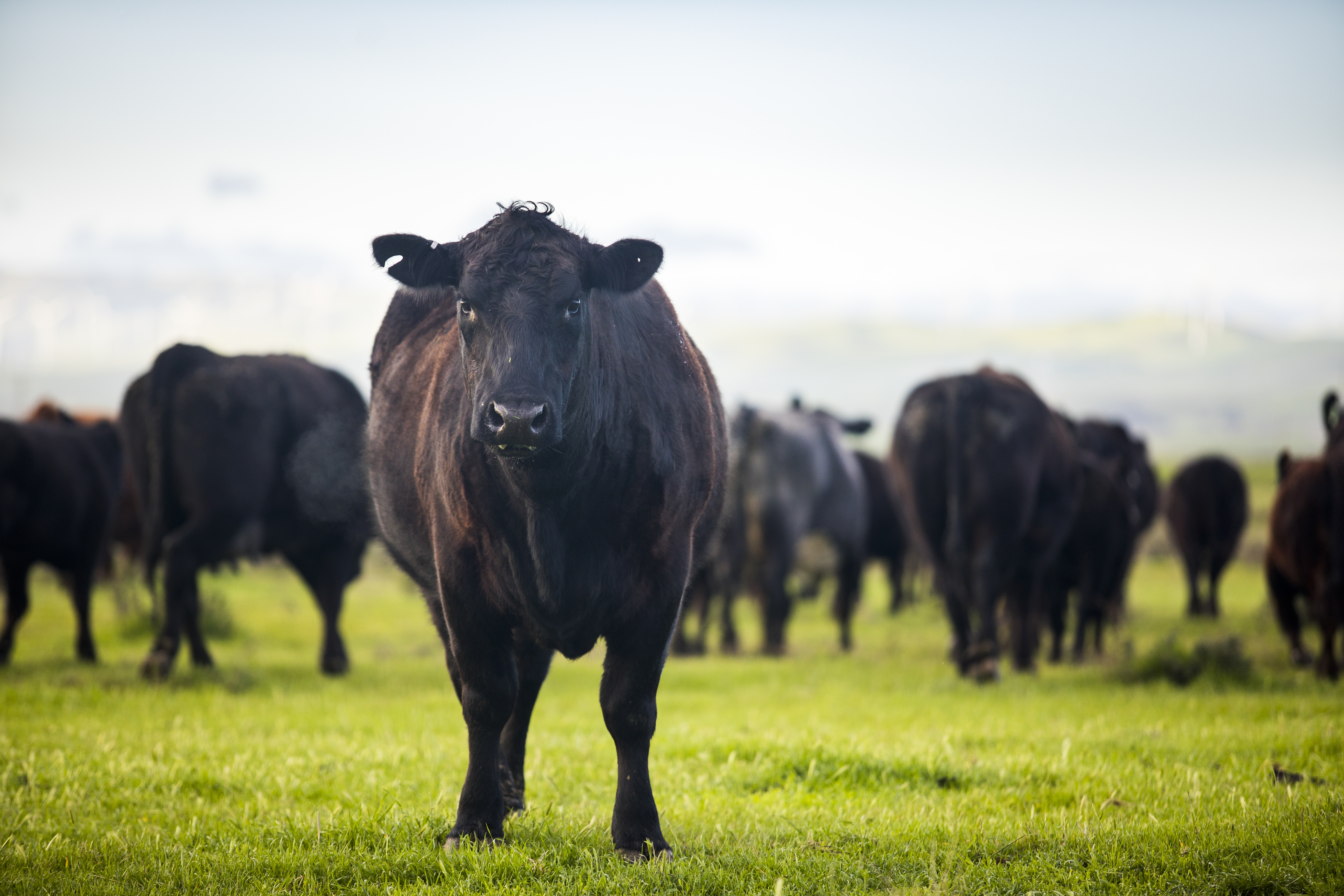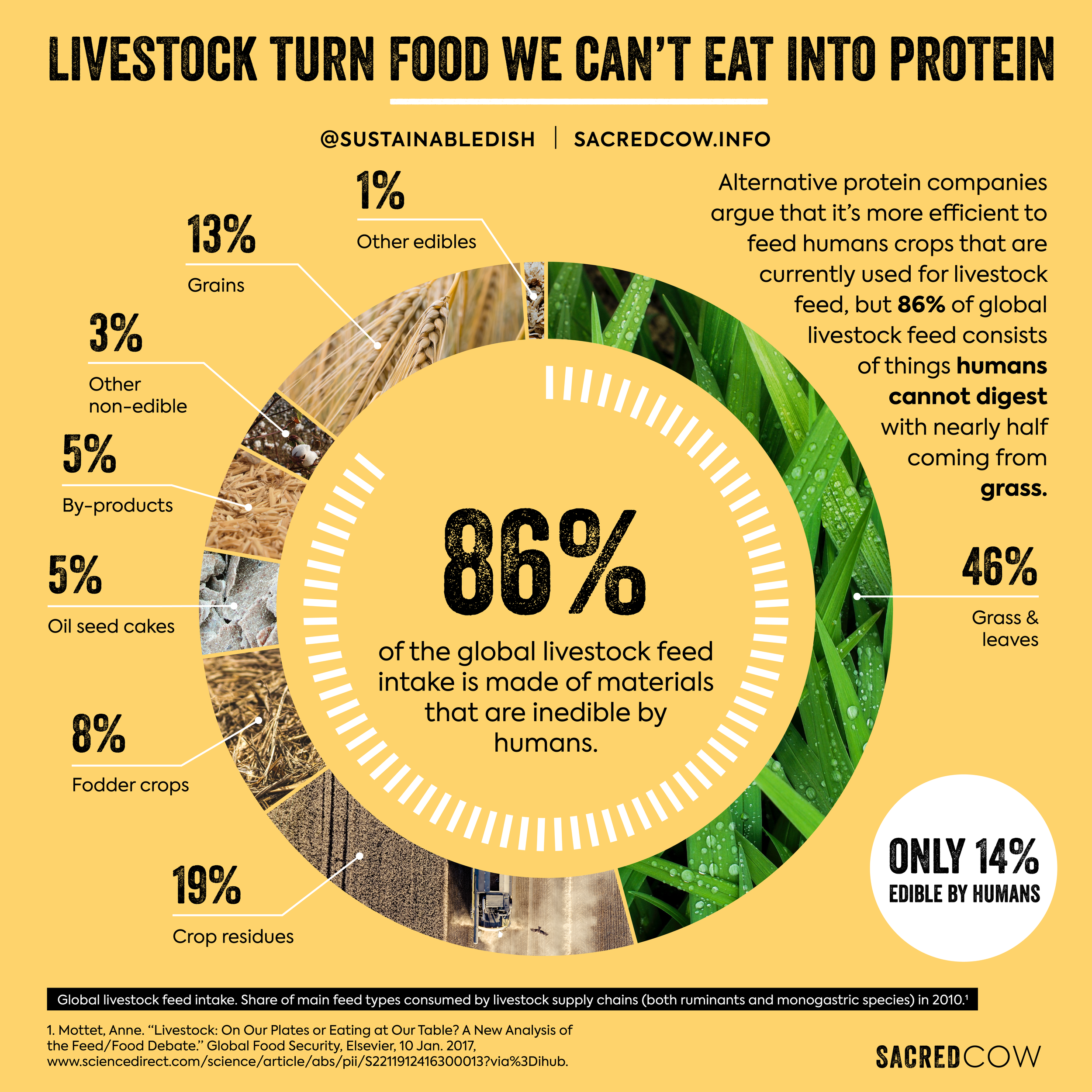Beef
For the most part, those of us from Alberta are well-versed in eating beef. Beef is the word for meat that comes from domesticated cows (cattle). Bovine is the word for the category of animals including cows and buffalo. Beef is the most common type of "red meat". "Steaks" and "hamburgers" are synonymous with beef.

Raising Cattle
Canada, Alberta specifically, is known for its ranching culture and high-quality beef. The beef industry is heavily regulated and monitored to assure consumers within the country and abroad that beef is safely raised and safe to consume. Cattle roam the pastures and eat grasses and alfalfa for most of the year but can be fed grains (corn and barley) in the winter or when it comes time to "fatten them up" for the market. Beef that are not fed grain as a finisher are referred to as "grass fed".
Cattle that is raised as veal are slaughtered at 200-225kg, or around 5 months. If a steer or heifer grow to around 18 months and 1350-1400kg they are ready to be slaughtered.
Cattle Classification
- Bulls: male cattle, usually not raised to be eaten
- Cows: female cattle after their first calving (birthing of a calf)
- Heifers: young cows before their first calving
- Stags: male cattle castrated after maturity
- Steers: castrated prior to maturity and specifically raised for beef
- Veal: young (pre-adolescent) bovine carcass
Muscle Composition
Beef is around 72% water (similar to other meats), 20% protein, 7% fat, and 1% carbohydrates. Due to the water content, beef shrinks when cooked. Beef is an excellent source of protein and lean cuts (less fat) can be eaten in small portions as part of a healthy and balanced diet.
Grading
In Canada, we have:
- Canada Prime
- AAA, AA, and A
- B1, B2, B3, B4
- D and E
Around 82% of beef production in Canada is Grade A or higher. Beef is graded on its muscle composition (texture), fat content and marbling, and colour of the muscle and fat, and ossification (hardening of bones). Beef is inspected at a Federal level and Provincial level both before and after slaughter.
Aging
There are 2 ways to age beef and improve its taste and texture;
- Dry aging: carcass is is held in a cooler
- Wet aging: smaller cuts are sealed in vacuum bags and stored in the cooler
Ways To Cook
Beef is extremely versatile. Hamburgers and steaks never seem to get old and the market for carnivores will always exist. To choose a cooking method, you must understand the cut of beef. Already tender cuts of beef (those that are exercised less) are suitable for fast-cooking methods like grilling, pan frying, or sautéing. Tougher cuts with a lot of connective tissue are best when cooked slowly and in moist heat cooking methods like braising and stewing.
Beef can be;
- grilled
- sautéed
- stewed
- braised
- cooked low temperature (sous vide in an immersion circulator)
- poached
- fried
- baked
- seared
- eaten raw
Additionally, marinating or smoking can help add flavour and tenderize meat. Other ways to tenderize include mechanical (using meat hammer/mallet) or chemical tenderizers (baking soda).
More on Cooking Beef
Some of our favourite videos

Alberta Beef Producers
Rocky Mountain Game Meats
About this producerFoods from this producer:
-
- Domesticated
- Fur
Beef
-
- Domesticated
- Feather
Chicken
-
- Domesticated
- Fur
Lamb
-
- Domesticated
- Fur
Pork
-
- Wild Game
- Fur
Bison
-
- Wild Game
- Fur
Venison
-
- Wild Game
- Fur
Wild Boar
-
- Wild Game
- Fur
Pronghorn
-
- Wild Game
- Fur
Rabbit
-
- Wild Game
- Feather
Duck
-
- Wild Game
- Feather
Partridge
-
- Wild Game
- Feather
Pheasant
-
- Domesticated
- Feather
Quail
Green Work Farms
About this producerFoods from this producer:
TK Ranch
About this producerFoods from this producer:
Herbert Family Farm
About this producerFoods from this producer:
Charlotte Lake Farms
About this producerFoods from this producer:
Coen Farm
About this producerFoods from this producer:
Nature's Green Acres
About this producerFoods from this producer:
Sunshine Organic Farm
About this producerLazuli Farms
About this producerFoods from this producer:
Homesteader Farms
About this producerFoods from this producer:
-
- Domesticated
- Feather
Egg (hen)
-
- Domesticated
- Fur
Beef
-
- Domesticated
- Fur
Lamb
-
Honey
-
- Vegetables
Potatoes
-
- Vegetables
- Roots and Tubers
Carrots
-
- Vegetables
- Roots and Tubers
Parsnip
-
- Vegetables
- Roots and Tubers
Beet
-
- Vegetables
Corn
-
- Vegetables
Cucumber
-
- Vegetables
Pumpkin
-
- Vegetables
Tomatoes
-
- Vegetables
Pea
-
- Vegetables
Green Bean
-
- Vegetables
Lettuce
-
- Vegetables
- Roots and Tubers
Radish
-
- Vegetables
Onion
-
- Herbs & Spices & Flavourings
- Culinary Herb
Dill
-
- Vegetables
- Cabbage Family
Cabbage
-
- Vegetables
- Cabbage Family
Broccoli
-
- Vegetables
Zucchini
-
- Fruit
Rhubarb
Ehrenholz Farms
About this producerGrazed Right Grass Fed Beef
About this producerFoods from this producer:
Hoven Farms
About this producerFoods from this producer:
The Saskaberry Ranch
About this producerBlue Ridge Farms
About this producerFoods from this producer:
Schielke Farm
About this producerFoods from this producer:
Redtail Farms
About this producerFoods from this producer:
Stonepost Farms
About this producerEdgar Farms
About this producerFoods from this producer:
Gemstone Grass Fed Beef
About this producerFoods from this producer:
Sunworks Farm
About this producerTrails End Beef
About this producerFoods from this producer:
-
Rocky Mountain Game Meats
Rocky Mountain Game Meats, 55 Avenue Northeast, Calgary, AB, Canada
-
Green Work Farms
49325 Range Road 262, Leduc County, AB, Canada
-
TK Ranch
TK Ranch, Inverlake Road, Calgary, AB, Canada
-
Herbert Family Farm
Herbert Family Farm, Range Road 201, Edberg, AB, Canada
-
Charlotte Lake Farms
Charlotte Lake Farms, Township Road 613, Bonnyville, AB, Canada
-
Coen Farm
Coen Farm, Ferintosh, AB, Canada
-
Nature's Green Acres
Nature's Green Acres, Viking, AB, Canada
-
Sunshine Organic Farm
Sunshine Organic Farm, Range Road 34, Warburg, AB, Canada
-
Lazuli Farms
Lazuli Farms, Township Road 484, Camrose, AB, Canada
-
Homesteader Farms
Homesteader Farms, Yellowhead County, Township Road 563A, Yellowhead County, AB, Canada
-
Ehrenholz Farms
Ehrenholz Farms, County of Barrhead No. 11, AB, Canada
-
Grazed Right Grass Fed Beef
Grazed Right, Black Diamond, AB, Canada
-
Hoven Farms
Hoven Farms Grass Finished Organic Beef, Eckville, AB, Canada
-
The Saskaberry Ranch
The Saskaberry Ranch, Township Road 324, Mountain View County, AB, Canada
-
Blue Ridge Farms
Blue Ridge Farms, Range Road 102, Blue Ridge, AB, Canada
-
Schielke Farm
21174 Township Road 455, New Norway, AB, Canada
-
Redtail Farms
Redtail Farms, Castor, AB, Canada
-
Stonepost Farms
Stonepost Farms, Range Road 105, Wildwood, AB, Canada
-
Edgar Farms
1465 Township Rd 352, Innisfail, AB T4G 0M8, Canada
-
Gemstone Grass Fed Beef
Gemstone Cattle Company, Range Road 164, Gem, AB, Canada
-
Sunworks Farm
Sunworks Farms, Armena, AB, Canada
-
Trails End Beef
273016 Township Rd 152, Nanton, AB T0L 1V0, Canada
Canada Beef - https://canadabeef.ca/
Sacred Cow - https://www.sacredcow.info/blog
Alberta Beef - https://open.alberta.ca/publications/alberta-beef
How Cattle Became Domesticated - https://www.thoughtco.com/history-of-the-domestication-of-cows-170652
Cattle: The Ultimate "Upcyclers" - https://www.beefitswhatsfordinner.com/raising-beef/upcycling
